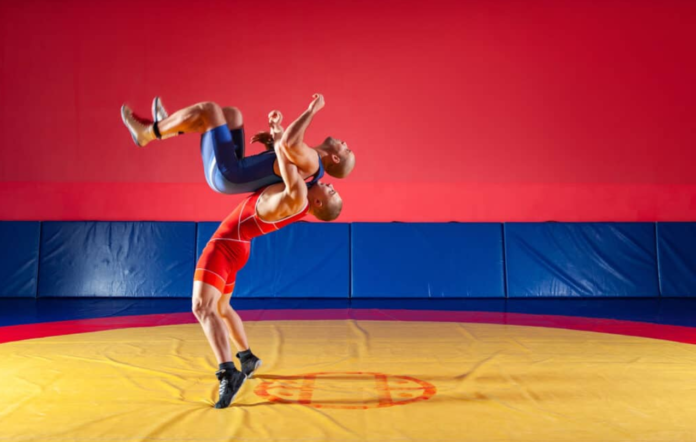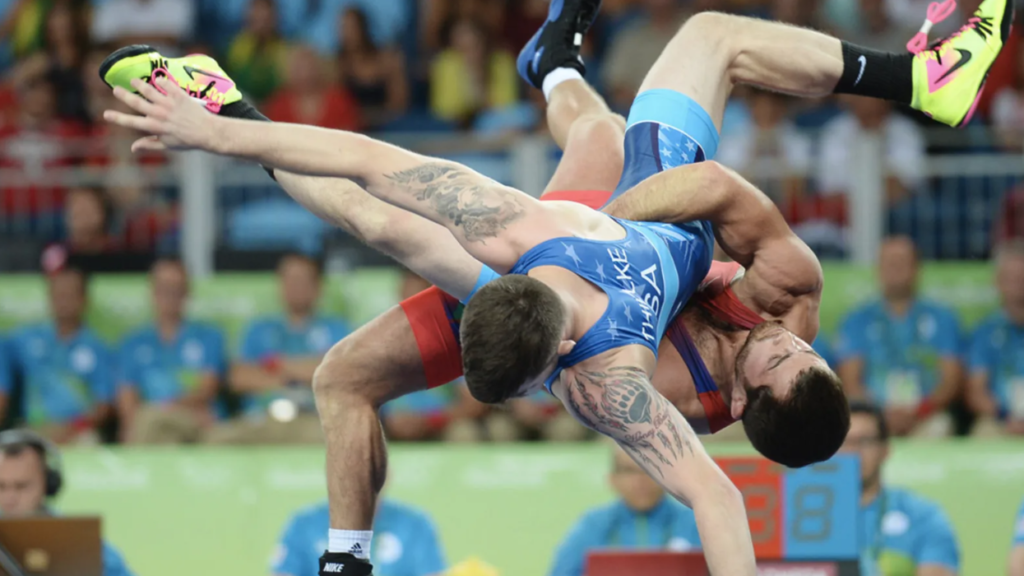
Folkstyle wrestling is one of the three main styles of wrestling, alongside freestyle and Greco-Roman wrestling. It is primarily practiced in the United States and is widely popular at the college and high school levels. It is known for its intense and physical nature, requiring wrestlers to use a combination of strength, technique, and strategy to defeat their opponents. In this guide, we’ll cover the history of folkstyle wrestling, the main moves used, the rules of college wrestling, and how you can integrate it into BJJ.
History Of Folkstyle Wrestling
Folkstyle wrestling has a rich history in the United States, with roots dating back to colonial times. The sport was initially developed as a way for colonists to defend themselves and their communities.
It has its roots in catch wrestling, which was popular in the late 19th and early 20th centuries. It was originally practiced in carnivals and fairs throughout the United States, and eventually evolved into a more organized sport. Over time, this type of wrestling became a popular pastime and was eventually incorporated into schools and universities as a competitive sport.
The first intercollegiate wrestling competition was held in 1850 between Yale and Columbia. Since 1912 folkstyle wrestling has been an NCAA-sanctioned sport.
Main Folkstyle Wrestling Moves
Folkstyle wrestling is an intense and exciting sport that requires a combination of strength, technique, and strategy. The four main categories of moves used in the modern version of this type of wrestling include takedowns, escapes, pins, and reversals.
Takedowns
Takedowns are one of the most essential moves in wrestling. They involve taking your opponent down to the mat, gaining control to keep them there, and attempting to score points.
The most common takedowns include the single-leg, double-leg, and high-crotch takedowns.
Escapes
Escapes are used when a wrestler is on the bottom and wants to get back to a standing position. They involve breaking free from an opponent’s hold and, ideally, reversing the position. Some common escapes easily recognizable from this style of wrestling include the stand-up, sit-out, and hip switch.
Pins
Pins are used to win a wrestling match by holding an opponent’s shoulders to the mat for a certain amount of time (usually around three seconds). Wrestlers can use various moves to pin their opponents, such as the cradle, half-nelson, and bar arm.
Reversals
Reversals are used to escape from a disadvantageous position and gain control of the match. They involve reversing the position of an opponent who has taken control. Common reversals include the Peterson roll and the Granby roll.
Rules Of College Wrestling
College wrestling adheres to a strict set of rules which have been well-established, given that the majority of practitioners are high school and college students, and the need for safety is paramount.
Weight Classes
College wrestling has ten weight classes, ranging from 125 pounds to 285 pounds. Wrestlers compete against opponents in their weight class, ensuring fair competition.
Scoring
Points are awarded for various moves and positions in college wrestling. Takedowns are worth two points, escapes and reversals are worth one point, and pins result in an immediate win. Points are also awarded for near-falls, where a wrestler almost pins their opponent.
Time Limits
Folkstyle wrestling matches consist of three periods, each lasting two minutes. The wrestler with the most points at the end of the match wins.
What Is The Difference Between Folkstyle And Freestyle Wrestling?
Two of the most wrestling popular styles, especially in western countries, are folkstyle and freestyle wrestling. While both styles share similarities, they also have significant differences that make them unique.
The main difference between folkstyle and freestyle wrestling is the set of rules that govern each sport. In folkstyle wrestling, wrestlers score points for takedowns, escapes, and pins, and are penalized for infractions such as stalling. The objective is to gain control over your opponent and pin them to the mat.
In freestyle wrestling, wrestlers also score points for takedowns, escapes, and pins, but the rules are more liberal, and wrestlers are encouraged to use more dynamic and explosive techniques. Wrestlers are allowed to use their legs to trip or throw their opponent, and are not penalized for stalling.
Another key difference between the two sports is the type of mat used. In folkstyle, the mat is typically made of foam or rubber, while in freestyle wrestling, the mat is made of a harder, more durable material that is designed to provide better traction and support.
What is Folkstyle Wrestling?
Folkstyle wrestling, also known as collegiate wrestling, is a popular style of wrestling in the United States. It is typically practiced at the high school and college levels. The goal of folkstyle wrestling is to pin your opponent’s shoulders to the mat for a set amount of time, or to score points through takedowns, escapes, and reversals.
What is Freestyle Wrestling?
Freestyle wrestling is a style of wrestling that is popular around the world, including at the Olympic level. Unlike folkstyle wrestling, the goal of freestyle wrestling is to score points through takedowns, throws, and exposure to your opponent’s back. Freestyle wrestling also has different weight classes and time limits than folkstyle wrestling.
Key Differences
- Scoring – In folkstyle, points are awarded for takedowns, escapes, reversals, and pins. In freestyle wrestling, points are awarded for takedowns, throws, and exposure to the opponent’s back.
- Time limits – In folkstyle wrestling, there are three periods of wrestling, each lasting two minutes. In freestyle, there are two periods, each lasting three minutes.
- Weight classes – The weight classes in freestyle wrestling are different than those in folkstyle wrestling. For example, the lightest weight class in freestyle wrestling is 57 kg, while in folkstyle, the lightest weight class is 106 lbs.
- Rules – There are different rules in folkstyle and freestyle wrestling. For example, in freestyle wrestling, a wrestler can win by technical superiority if they are ahead by 10 or more points. In folkstyle wrestling, the point differential must be at least 15 points to win by technical superiority.
How Folkstyle Wrestling Can Benefit Your BJJ Training
Folkstyle wrestling is a grappling sport that has many benefits for Brazilian Jiu-Jitsu practitioners. The techniques and principles learned in folkstyle wrestling can greatly enhance your BJJ learning curve, through the mastery of better takedowns, improved control and pressure on the ground, increased stamina and conditioning, and the “feel” for effective transitioning.
Whether you are a beginner or an experienced practitioner, adding certain aspects of folkstyle wrestling to your training regimen can help you take your game to the next level.
Better Takedowns
Folkstyle wrestling is well-known for its focus on takedowns. Unlike BJJ, which starts on the ground, folkstyle is all about getting your opponent to the mat. This means that wrestlers develop a wide range of takedown techniques, including singles, doubles, high crotches, and more.
By learning and practicing these takedowns, you can improve your standing game and take your opponents down more easily, effectively and safely. This not only puts you in a dominant position but also makes it easier to apply BJJ submissions and control.
Increased Control and Pressure
Folkstyle wrestling places a lot of emphasis on controlling one’s opponent on the mat. This involves using the directional placement of your own body weight and leverage to apply pressure and limit the opponent’s movement. By mastering these techniques, wrestlers can effectively control and dominate their opponents.
In BJJ, the ability to control and pressure opponents is also crucial, particularly when it comes to maintaining dominant (scoring) positions and eventually applying submissions. By incorporating folkstyle techniques into your BJJ training, you can develop a far more dominant ground game than by only training Jiu-Jitsu.
Improved Stamina and Conditioning
Wrestling, especially folkstyle, is an incredibly demanding sport that requires a high level of fitness and conditioning. Wrestlers must be able to maintain their energy and focus for extended periods, even during the most grueling matches.
By practicing folkstyle in addition to Jiu-Jitsu, submission grapplers can improve their fight-specific conditioning, allowing them to last longer and perform better during rolling sessions and competitions. This can also help to prevent fatigue-related injuries, which are the main cause of injuries in BJJ athletes.
Effective Transitioning
Transitioning is a critical aspect of both folkstyle wrestling and BJJ. In folkstyle, transitions are all about moving between different positions and techniques in a seamless and effective way. In BJJ, transitions involve slower movement between submissions, sweeps, and positional changes, which is how improved positional control connects to its aspect of dynamic grappling.
By training in both folkstyle wrestling and BJJ, you can develop a more effective and versatile transitional game. You can learn how to anticipate and respond to your opponent’s movements and take advantage of openings to gain dominant positions and apply submissions.
Conclusion
In conclusion, folkstyle wrestling is a rich and vibrant sport with a long and storied history. It is a sport that requires discipline, strength, and perseverance, and it has a variety of benefits that extend beyond the mat. The main moves, including takedowns, escapes, pins, and reversals, are essential techniques that are fundamental to a wrestler’s success. If you are a BJJ practitioner looking to improve your takedowns, control, stamina, and transitioning, incorporating this wrestling style into your training regimen can be incredibly beneficial.


![Darce Choke Encyclopedia – Origins, Mechanics and Variations [2025] BJJ, choke, Brabo, BJJ Darce Choke, D'arce Choke, Darce BJJ Choke](https://bjj-world.com/wp-content/uploads/2017/11/JungPoirierLeeYahoo-218x150.jpg)













![Countering with Crab Ride Anthony Budion DVD Review [2025] Countering with Crab Ride Anthony Budion DVD Review](https://bjj-world.com/wp-content/uploads/2025/03/countering-with-crab-ride-anthony-budion-dvd-review-218x150.png)
![Closet Closed Guard Craig Jones DVD Review [2025] Closet Closed Guard Craig Jones DVD Review](https://bjj-world.com/wp-content/uploads/2025/03/closet-closed-guard-craig-jones-dvd-review-218x150.png)
![Xanadu Back Takes Levi Jones-Leary DVD Review [2025] Xanadu Back Takes Levi Jones-Leary DVD Review](https://bjj-world.com/wp-content/uploads/2025/03/xanadu-back-takes-levi-jones-leary-dvd-review-218x150.png)

![No-Gi Grapplers Guide To Front Headlock Joel Bane DVD Review [2025] No-Gi Grapplers Guide To Front Headlock Joel Bane DVD Review](https://bjj-world.com/wp-content/uploads/2025/03/no-gi-front-headlock-joel-bane-dvd-review-218x150.png)

![Full Guard Formula James Booth DVD Review [2025] Full Guard Formula James Booth DVD Review](https://bjj-world.com/wp-content/uploads/2025/02/full-guard-formula-james-booth-dvd-review-324x235.png)
![Feet Finder Foot Sweeps Christian Ozbek DVD Review [2024] Feet Finder Foot Sweeps Christian Ozbek DVD Review](https://bjj-world.com/wp-content/uploads/2024/09/feet-finder-foot-sweeps-christian-ozbek-dvd-review-100x70.png)
![Zen Guide To Submission Grappling Margot Ciccarelli DVD Review [2025] Zen Guide To Submission Grappling Margot Ciccarelli DVD Review](https://bjj-world.com/wp-content/uploads/2025/02/submission-grappling-margot-ciccarelli-dvd-preview-100x70.png)
![Darces From Everywhere Kade and Tye Ruotolo DVD Review [2024] Darces From Everywhere Kade and Tye Ruotolo DVD Review](https://bjj-world.com/wp-content/uploads/2024/10/darces-from-everywhere-kade-and-tye-ruotolo-dvd-cover-100x70.png)





![I Got Your Back Jake Straus DVD Review [2025] I Got Your Back Jake Straus DVD Review](https://bjj-world.com/wp-content/uploads/2025/03/i-got-your-back-jake-straus-dvd-review-100x70.png)


![No-Gi Grapplers Guide To Front Headlock Joel Bane DVD Review [2025] No-Gi Grapplers Guide To Front Headlock Joel Bane DVD Review](https://bjj-world.com/wp-content/uploads/2025/03/no-gi-front-headlock-joel-bane-dvd-review-100x70.png)
![Just Pass Jay Rodriguez DVD Review [2024] Just Pass Jay Rodriguez DVD Review](https://bjj-world.com/wp-content/uploads/2024/11/just-pass-jay-rodriguez-dvd-review-100x70.png)





![Charles Allan Price Building Workouts For BJJ DVD Review [2024] Charles Allan Price Building Workouts For BJJ DVD Review](https://bjj-world.com/wp-content/uploads/2024/09/charles-allan-price-building-workouts-for-bjj-review-100x70.png)

![Ginastica Natural Alvaro Romano DVD Review [2024] Ginastica Natural Alvaro Romano DVD Review](https://bjj-world.com/wp-content/uploads/2024/12/ginastica-natural-alvaro-romano-dvd-review-100x70.png)


![Mastering Takedown Prevention Steve Mocco DVD Review [2024] Mastering Takedown Prevention Steve Mocco DVD Review](https://bjj-world.com/wp-content/uploads/2024/11/mastering-takedown-prevention-steve-mocco-dvd-review-100x70.png)


